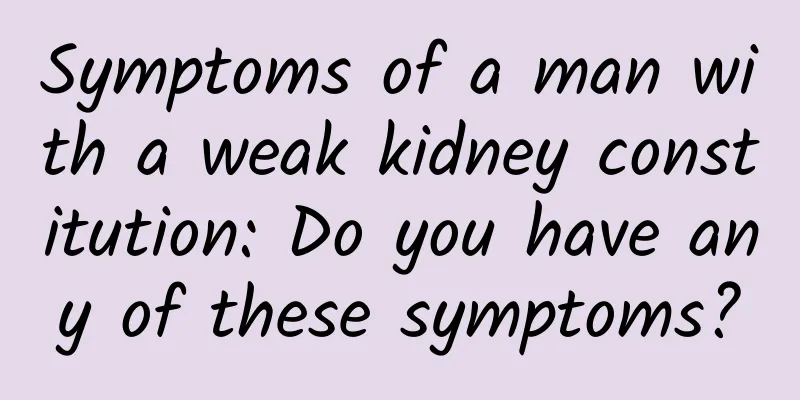Male lower abdominal distension with back pain

|
It is very common for men to have low back pain, and there are many reasons for it. However, if it is accompanied by lower abdominal distension, it may be caused by urinary tract infection or prostatitis. Both of these diseases are easy to occur and are very harmful. As for what kind of situation men with lower abdominal distension and low back pain belong to, we need to understand the disease and make a comprehensive judgment based on our own situation before we can draw a conclusion. One is urinary tract infection Clinical manifestations 1. Acute simple cystitis The onset is sudden, and female patients are often related to sexual activity. The main manifestations are bladder irritation symptoms, i.e. frequent urination, urgency, pain, discomfort in the bladder area or perineum, and urethral burning sensation; the degree of urinary frequency varies, and severe cases may have urgency urinary incontinence; cloudy urine, white blood cells in the urine, terminal hematuria, sometimes whole-course hematuria, and even blood clots. Generally, there are no obvious systemic infection symptoms, and the body temperature is normal or there is a low fever. 2. Acute simple pyelonephritis (1) Urinary system symptoms include bladder irritation symptoms such as frequent urination, urgency, and pain during urination; hematuria; low back pain on the affected side or both sides; obvious tenderness or percussion pain at the costovertebral angle on the affected side; (2) Symptoms of systemic infection such as chills, high fever, headache, nausea, vomiting, loss of appetite, etc. are often accompanied by increased white blood cell count and increased erythrocyte sedimentation rate. 3. Asymptomatic bacteriuria Asymptomatic bacteriuria is a type of occult urinary tract infection, which is more common in elderly women and pregnant women. Patients do not have any symptoms of urinary tract infection, and the incidence increases with age. 4. Complicated urinary tract infection The clinical manifestations of complicated urinary tract infection vary greatly. It is often accompanied by other diseases that increase the risk of infection or treatment failure, and may or may not be accompanied by clinical symptoms (such as frequent urination, urgency, pain, dysuria, back pain, costovertebral angle pain, suprapubic pain and fever, etc.). Complicated urinary tract infection is often accompanied by other diseases, such as diabetes and renal failure; it also causes many sequelae, the most serious and fatal cases include urinary tract toxemia and renal failure, renal failure can be divided into acute and chronic, reversible and irreversible, etc. Second, it may be prostatitis Clinical manifestations Type I prostatitis often develops suddenly, with symptoms such as chills, fever, fatigue, and other systemic symptoms, accompanied by pain in the perineum and pubic area, frequent urination, urgency, rectal irritation, and even acute urinary retention. The clinical symptoms of type II and type III prostatitis are similar, mostly with pain and abnormal urination. Regardless of the type of chronic prostatitis, similar clinical symptoms can be manifested, collectively referred to as prostatitis syndrome, including pelvic and sacral pain, abnormal urination and sexual dysfunction. Pelvic and sacral pain is extremely complex. The pain is generally located above the pubic bone, lumbosacral region and perineum. Radiating pain can manifest as pain in the urethra, spermatic cord, testicles, groin, and inner side of the abdomen. It radiates to the abdomen and resembles acute abdominal pain. It radiates along the urinary tract and resembles renal colic, which often leads to misdiagnosis. Abnormal urination is manifested as frequent urination, urgent urination, painful urination, sluggish urination, bifurcated urine stream, dripping after urination, increased frequency of nocturia, and milky white secretions from the urethra after urination or during defecation. Occasionally, sexual dysfunction may occur, including decreased libido, premature ejaculation, painful ejaculation, weak erections, and impotence. Type IV prostatitis has no clinical symptoms and evidence of inflammation is only found during prostate examinations. |
>>: What are the symptoms of cold in men?
Recommend
What is the reason for blood in boys' urine
Sometimes in daily life, a very small number of m...
What is the traditional Chinese medicine method for treating impotence?
Many young men suffer from impotence. At this tim...
Is it okay to train abdominal muscles on the horizontal bar?
What do girls like most in boys? The answer is of...
What causes right inguinal pain?
The groin is mainly an active area and is also a ...
Pictures of pimples on male testicles
Key reminder: Many men are not familiar with the ...
Effects of father's drug abuse on the fetus
During the period of preparing for pregnancy, whe...
How to treat lumbar fracture? These two methods are worth choosing
In social life, many people suffer from fractures...
Male urethra has a pimple
Men's reproductive health is very important t...
How to treat low sperm survival rate?
The health of male sperm is very important, becau...
What should you pay attention to when eating for orchitis?
Orchitis is a common disease in men. In addition,...
What causes men to feel dizzy and nauseous?
Although men are healthier than women, with the a...
Anemia in men is very harmful
Anemia is common among female friends in daily li...
The male protagonist has autism and is paranoid
If a boy is found to have autism, he needs to rec...
How to treat fungal infection of the glans penis
Fungal infection of the glans penis is a common d...
Why is the glans blistering and itching?
Many people pay close attention to some changes i...









